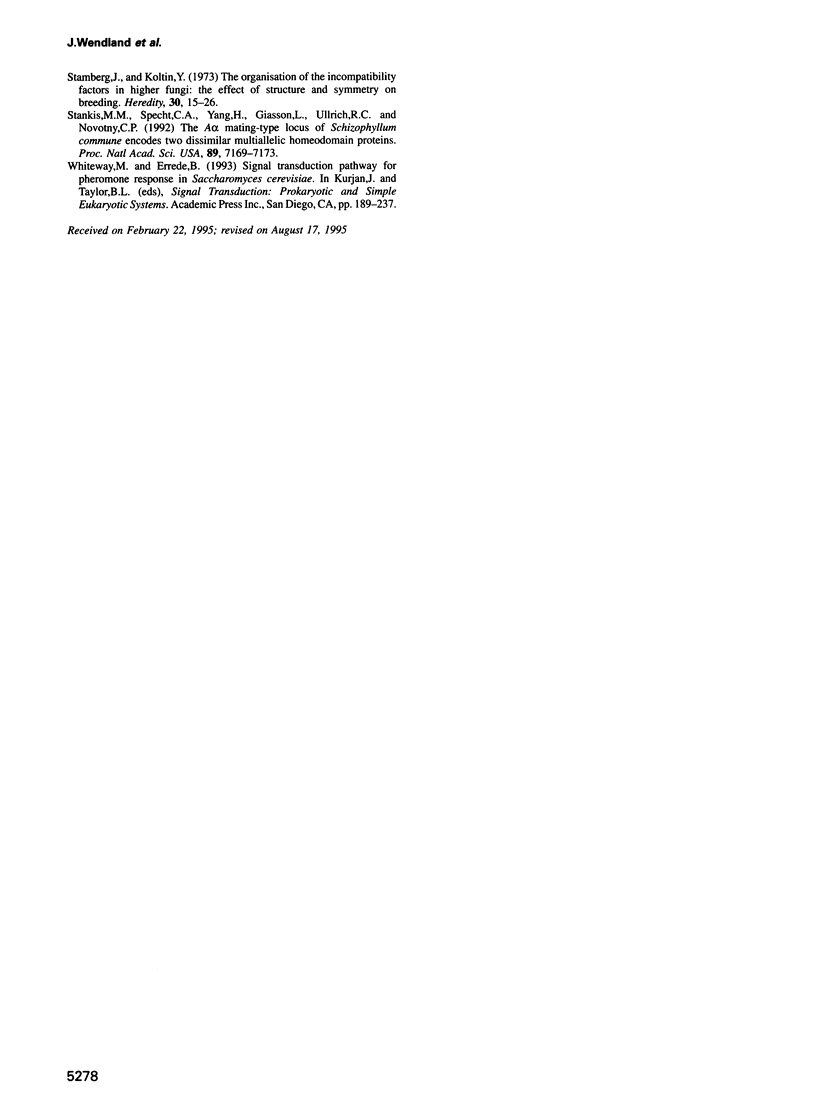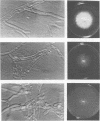Abstract
Analysis of the multispecific B alpha mating-type locus of Schizophyllum commune provided evidence that pheromones and pheromone receptors govern recognition of self versus non-self and sexual development in this homobasidiomycetous fungus. Four subclones of an 8.2 kb genomic fragment carrying B alpha 1 specificity induced B-regulated sexual morphogenesis when introduced into a strain with one of the eight compatible B alpha specificities that are known to exist in nature. One of these clones, which activated all other B alpha specificities, contains a gene termed bar1. The predicted protein product of bar1, as well as that of bar2, a homologous gene isolated from a B alpha 2 strain, has significant homology to known fungal pheromone receptor proteins in the rhodopsin-like superfamily of G protein-linked receptors. The other three active B alpha 1 clones were subcloned further to identify the minimal active element in each clone. Every active subclone contains a putative pheromone gene ending in a signal for possible isoprenylation. A message of approximately 600 bp was observed for one of these genes, bap1(1). This paper presents the first evidence for a system of multiple pheromones and pheromone receptors as a basis for multispecific mating types in a fungus.
Full text
PDF







Images in this article
Selected References
These references are in PubMed. This may not be the complete list of references from this article.
- Baldwin J. M. Structure and function of receptors coupled to G proteins. Curr Opin Cell Biol. 1994 Apr;6(2):180–190. doi: 10.1016/0955-0674(94)90134-1. [DOI] [PubMed] [Google Scholar]
- Banuett F., Herskowitz I. Different a alleles of Ustilago maydis are necessary for maintenance of filamentous growth but not for meiosis. Proc Natl Acad Sci U S A. 1989 Aug;86(15):5878–5882. doi: 10.1073/pnas.86.15.5878. [DOI] [PMC free article] [PubMed] [Google Scholar]
- Bölker M., Kahmann R. Sexual pheromones and mating responses in fungi. Plant Cell. 1993 Oct;5(10):1461–1469. doi: 10.1105/tpc.5.10.1461. [DOI] [PMC free article] [PubMed] [Google Scholar]
- Bölker M., Urban M., Kahmann R. The a mating type locus of U. maydis specifies cell signaling components. Cell. 1992 Feb 7;68(3):441–450. doi: 10.1016/0092-8674(92)90182-c. [DOI] [PubMed] [Google Scholar]
- Clarke S. Protein isoprenylation and methylation at carboxyl-terminal cysteine residues. Annu Rev Biochem. 1992;61:355–386. doi: 10.1146/annurev.bi.61.070192.002035. [DOI] [PubMed] [Google Scholar]
- Froeliger E. H., Leong S. A. The a mating-type alleles of Ustilago maydis are idiomorphs. Gene. 1991 Apr;100:113–122. doi: 10.1016/0378-1119(91)90356-g. [DOI] [PubMed] [Google Scholar]
- Froeliger E. H., Muñoz-Rivas A. M., Specht C. A., Ullrich R. C., Novotny C. P. The isolation of specific genes from the basidiomycete Schizophyllum commune. Curr Genet. 1987;12(7):547–554. doi: 10.1007/BF00419565. [DOI] [PubMed] [Google Scholar]
- Giasson L., Specht C. A., Milgrim C., Novotny C. P., Ullrich R. C. Cloning and comparison of A alpha mating-type alleles of the Basidiomycete Schizophyllum commune. Mol Gen Genet. 1989 Jul;218(1):72–77. doi: 10.1007/BF00330567. [DOI] [PubMed] [Google Scholar]
- Gillissen B., Bergemann J., Sandmann C., Schroeer B., Bölker M., Kahmann R. A two-component regulatory system for self/non-self recognition in Ustilago maydis. Cell. 1992 Feb 21;68(4):647–657. doi: 10.1016/0092-8674(92)90141-x. [DOI] [PubMed] [Google Scholar]
- Koltin Y., Raper J. R., Simchen G. The genetic structure of the incompatibility factors of Schizophyllum commune: the B factor. Proc Natl Acad Sci U S A. 1967 Jan;57(1):55–62. doi: 10.1073/pnas.57.1.55. [DOI] [PMC free article] [PubMed] [Google Scholar]
- Kurjan J. Pheromone response in yeast. Annu Rev Biochem. 1992;61:1097–1129. doi: 10.1146/annurev.bi.61.070192.005313. [DOI] [PubMed] [Google Scholar]
- Kües U., Richardson W. V., Tymon A. M., Mutasa E. S., Göttgens B., Gaubatz S., Gregoriades A., Casselton L. A. The combination of dissimilar alleles of the A alpha and A beta gene complexes, whose proteins contain homeo domain motifs, determines sexual development in the mushroom Coprinus cinereus. Genes Dev. 1992 Apr;6(4):568–577. doi: 10.1101/gad.6.4.568. [DOI] [PubMed] [Google Scholar]
- Lengeler K., Kothe E. Molecular characterization of ura1, a mutant allele for orotidine-5'- monophosphate decarboxylase in Schizophyllum commune. FEMS Microbiol Lett. 1994 Jun 1;119(1-2):243–247. doi: 10.1111/j.1574-6968.1994.tb06895.x. [DOI] [PubMed] [Google Scholar]
- Lucas M. C., Jacobson J. W., Giles N. H. Characterization and in vitro translation of polyadenylated messenger ribonucleic acid from Neurospora crassa. J Bacteriol. 1977 Jun;130(3):1192–1198. doi: 10.1128/jb.130.3.1192-1198.1977. [DOI] [PMC free article] [PubMed] [Google Scholar]
- Marsh L., Neiman A. M., Herskowitz I. Signal transduction during pheromone response in yeast. Annu Rev Cell Biol. 1991;7:699–728. doi: 10.1146/annurev.cb.07.110191.003411. [DOI] [PubMed] [Google Scholar]
- Munoz-Rivas A., Specht C. A., Drummond B. J., Froeliger E., Novotny C. P., Ullrich R. C. Transformation of the basidiomycete, Schizophyllum commune. Mol Gen Genet. 1986 Oct;205(1):103–106. doi: 10.1007/BF02428038. [DOI] [PubMed] [Google Scholar]
- Muñoz-Rivas A. M., Specht C. A., Ullrich R. C., Novotny C. P. Isolation of the DNA sequence coding indole-3-glycerol phosphate synthetase and phosphoribosylanthranilate isomerase of Schizophyllum commune. Curr Genet. 1986;10(12):909–913. doi: 10.1007/BF00398288. [DOI] [PubMed] [Google Scholar]
- Raper C. A., Raper J. R. Mutational analysis of a regulatory gene for morphogenesis in Schizophyllum. Proc Natl Acad Sci U S A. 1973 May;70(5):1427–1431. doi: 10.1073/pnas.70.5.1427. [DOI] [PMC free article] [PubMed] [Google Scholar]
- Raper C. A., Raper J. R. Mutations modifying sexual morphogenesis in schizophyllum. Genetics. 1966 Nov;54(5):1151–1168. doi: 10.1093/genetics/54.5.1151. [DOI] [PMC free article] [PubMed] [Google Scholar]
- Raper J. R., Baxter M. G., Middleton R. B. THE GENETIC STRUCTURE OF THE INCOMPATIBILITY FACTORS IN SCHIZOPHYLLIUM COMMUNE. Proc Natl Acad Sci U S A. 1958 Sep 15;44(9):889–900. doi: 10.1073/pnas.44.9.889. [DOI] [PMC free article] [PubMed] [Google Scholar]
- Schulz B., Banuett F., Dahl M., Schlesinger R., Schäfer W., Martin T., Herskowitz I., Kahmann R. The b alleles of U. maydis, whose combinations program pathogenic development, code for polypeptides containing a homeodomain-related motif. Cell. 1990 Jan 26;60(2):295–306. doi: 10.1016/0092-8674(90)90744-y. [DOI] [PubMed] [Google Scholar]
- Sen M., Marsh L. Noncontiguous domains of the alpha-factor receptor of yeasts confer ligand specificity. J Biol Chem. 1994 Jan 14;269(2):968–973. [PubMed] [Google Scholar]
- Specht C. A., Stankis M. M., Giasson L., Novotny C. P., Ullrich R. C. Functional analysis of the homeodomain-related proteins of the A alpha locus of Schizophyllum commune. Proc Natl Acad Sci U S A. 1992 Aug 1;89(15):7174–7178. doi: 10.1073/pnas.89.15.7174. [DOI] [PMC free article] [PubMed] [Google Scholar]
- Spellig T., Bölker M., Lottspeich F., Frank R. W., Kahmann R. Pheromones trigger filamentous growth in Ustilago maydis. EMBO J. 1994 Apr 1;13(7):1620–1627. doi: 10.1002/j.1460-2075.1994.tb06425.x. [DOI] [PMC free article] [PubMed] [Google Scholar]
- Stankis M. M., Specht C. A., Yang H., Giasson L., Ullrich R. C., Novotny C. P. The A alpha mating locus of Schizophyllum commune encodes two dissimilar multiallelic homeodomain proteins. Proc Natl Acad Sci U S A. 1992 Aug 1;89(15):7169–7173. doi: 10.1073/pnas.89.15.7169. [DOI] [PMC free article] [PubMed] [Google Scholar]




